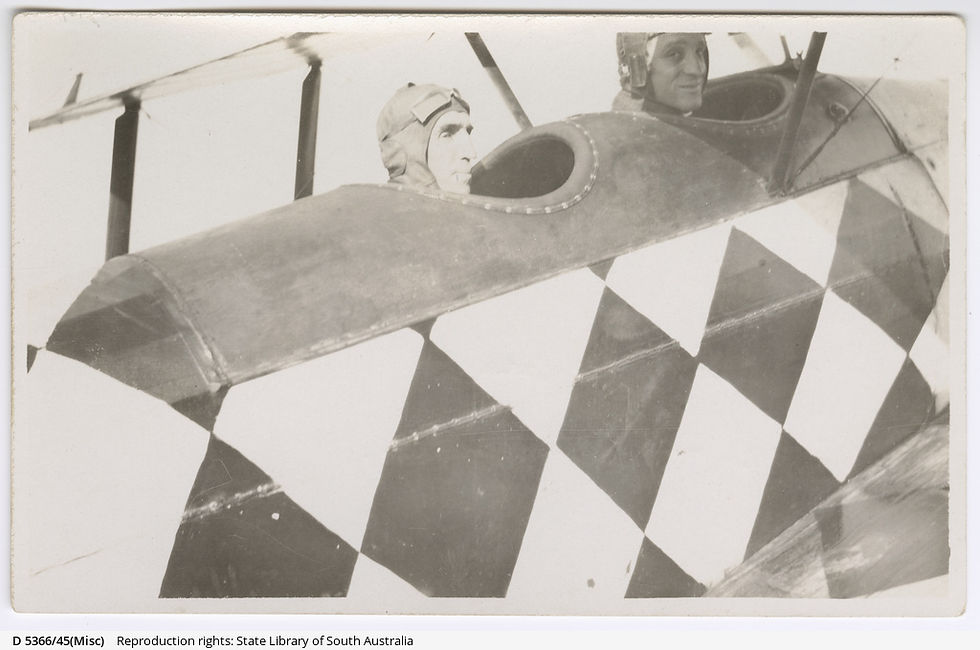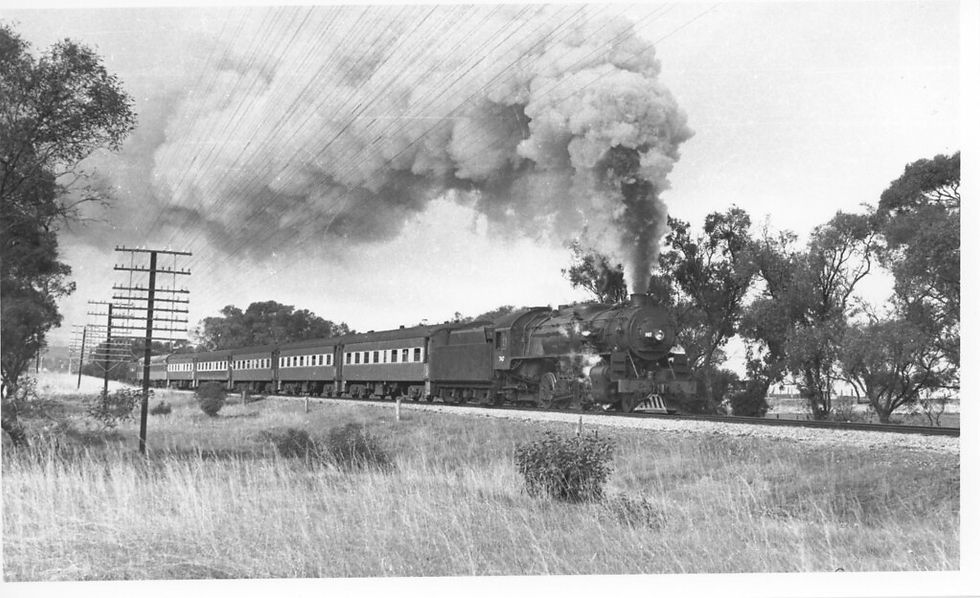Music Making in the Clare Valley
- ruwoltjon
- Nov 15, 2021
- 6 min read
The Bishop family - Clare Orchestra - Arthur Bishop, conductor - Clare Brass Band - Guilford Bishop - Richard Bishop - Boconnoc Park - Thelma Bishop - Pacer, Tycoon - Bishop Emigration from England
Clare, during the 1890s to 1940s, was a place of splendid musical happenings and entertainment.
The town had an excellent orchestra of up to 75 members, also a very active town band.
Orchestral concerts in the Town Hall, band competitions, street marches and Sunday afternoon concerts from the Bain Rotunda at the Clare oval were features of this musical era.
At the centre of this activity was the Bishop family — Mr and Mrs Arthur Bishop, their sons, Algie, Cliff and Guilford, and their daughter, Thelma.
In the previous generation of the Bishop family, there was the great support which came from Grandfather, Richard Bishop.

Mr Arthur Bishop was the genial proprietor of the local barber salon, but his leisure hours were filled with music.
The children, Algie [cornet and euphonium], Cliff [cello], Guilford [violin] and Thelma [piano], were excellent musicians and were dedicated members of the Clare Orchestra, where Thelma also played the bells and the tubaphone.
Other musicians in the orchestra included
Frank Knappstein [bass drum],
Cliff Birks [flute],
Roy James [flute],
Hec Shaw [side drums],
Stan Horrocks [slide trombone],
Bert Aitken [cornet],
Eric Smith [cornet],
Ethel Lewcock [piano],
Marj Aitken [organ & xylophone], and
the violinists — the Slattery girls, Jack Woolley, Les Jarman, Una and Eva Scott, and Lucy Ohlmeyer.

Left: Music for the Clare Orchestra handwritten by Arthur Bishop
Arthur Bishop, a son of Richard and Elizabeth Bishop, could play most instruments.
He was a conductor of both the Clare Orchestra and the Clare Town Band.
He also transposed much of the music, hand-writing sheet after sheet of crochets and quavers for each section of the orchestra.
He used a special pen which he wielded with great speed and dexterity.
In 1928 at a Back-to-Clare, Arthur Bishop conducted the Clare Band which made frequent appearances, enlivening each function with the quality and verve of the renditions.

Clare Brass Band in the 1920s From Left — Back Row: Bert Coles, ? , Bill Sharpen, ?, ? , Stan Forth, Algie Bishop, Arnold Pink, ? , Job Hamlyn Middle Row: Stan Pink, Wally Ash, Frank Phillips, Eddie Fryer, ? , Ike Duck, Stan Fowler, Stan Horrocks, Les Jarman, ? , Ern Phillips, Arthur Bishop, ? , ? , ? , Sitting: Frank Knappstein, Hec Shaw
The band competitions were stirring occasions when residents lined Main Street to revel in the music of the brass bands and the school fife bands, and applaud the musicians, resplendent in their uniforms, playing instruments which glowed from the care they received.
Mr Bishop was a conductor, too, of the Methodist church choir and the Sunday school anniversary, when students and worshippers packed the church three times each day on the two consecutive anniversary Sundays each year.
Guilford Bishop
Artists of a high calibre performed in Clare, but none more talented than Guilford Bishop who, in the 1930s, was associated with Radio Station 3LO Melbourne.
In 1935, he was appointed a member of the new permanent orchestra of the ABC, as a violinist, a position which he enjoyed for many years.
He continued to return to Clare as a guest artist or conductor.
In 1931, two concerts in the Town Hall by the Clare Orchestra, with Guilford Bishop as conductor, were broadcast over radio station 5CL.
He was offered a scholarship to go to America to further his studies and musical career but he rejected it, preferring to remain in Australia.
What were the origins of all this talent?
Richard Bishop

Right: Richard Bishop with his Cello
The musical ability of the Bishop family was inherited from Richard Bishop, who lived in Clare from 1858.
He was 10 years old when he arrived in S.A. from London, with his parents on the ship Caroline.
As he grew, his love of music developed and he learnt to play most instruments.
For 37 years, he was the conductor of the Methodist church choir, was a foundation member of the Philharmonic Society
[which was begun by Dr Bain],
and was a foundation member of an early Clare orchestra.
Something more will be said later about Richard's parents who came to South Australia.
Mr Richard Bishop was a contracting mason who built a large number of business premises and private homes prior to 1900.

They are standing monuments to his good workmanship.
Ironically, in the 1880s, he also built the magnificent homestead on Bocconoc Park which was later the home of his grand-daughter, Thelma.
Left: Bocconoc Park
The stone for this large home was quarried from Hope's Hill, behind Wolta Wolta, and carted to the site by wagon.
With his workmen, Richard Bishop often walked the seven miles from Clare to Bocconoc Park, then walked home again after the finish of a long day's building.
Richard and his wife, Elizabeth, raised their family in a stone home at 5 Hope Street.
In this house in the 1900s, Miss Flo Bishop conducted a guest house which was well known and recommended to many visitors to Clare.
Thelma Bishop
Arthur Bishop, after his marriage to Elsie Reynolds, lived in a house in William Street and it was here that their daughter, Thelma, was born in 1901.
She learnt the piano from Miss Webb in Union Street, and often played piano trios, with her special friends Lina Pearce and Madge Read, in Miss Webb's concerts.
They also rode home from music at breakneck speed on the one bicycle, pelting down steep Mill Street, into Old North Road — as a trio! — One on the seat, one on the handle-bars, and the other on the carrier.
Thelma attributed their survival to the fact that there were very few vehicles on the road in 1910.
At the Clare Primary School, she met the boy, Harold Brooks, whom she was to marry later.
The parents of Harold Brooks owned Bocconoc Park, a property a few miles west of the town.
They married in the Methodist church on a Wednesday in 1925.
The shops in Clare were closed on Wednesday afternoons from the year 1886 until 1947, so this was a popular day for weddings.
Her three bridesmaids were dressed in the rainbow colours of pink, blue and lavender.
The young marrieds moved into a house on Bocconoc Park where there was a large farming operation, with top quality merino stud sheep and world class trotting horses.
With a house to run and later, two children [Floyd and Molly] to care for, Thelma was not involved in the running of the property but two events, in particular, remain very clear in her memory.
One happened in 1942 when one of their stud rams, Royalist, brought the world record price for a merino ram, of £4,100.
The other was the death of their stylish, champion pacer, Tycoon, which was sired by Van Derby in 1942.
Tycoon was a bay horse of 15½ hands, with four white socks and a beautiful flowing tail.
In his career, he won many awards in South Australia, including that of S.A. 2-year-old champion pacer.
His top performance was winning the Pacing Derby at the Wayville trotting track in 1949. In that race he made a very slow start, but Tycoon, driven by Frank Shinn, performed brilliantly to win and create a record track time in what was considered to be the best performance ever seen at Wayville.

He later became a family pet, and was a beautiful animal, both in looks and nature.
On the day of his death, Tycoon had escaped from his usual enclosure and was running down an incline, when he fell in a culvert, broke his legs and had to be destroyed.
Thelma recalls how upset everyone was at the loss of this big-hearted champion.
In 1966, Mr and Mrs Harold Brooks left their property in the capable hands of Floyd and his wife Margaret.
They moved first to Victor Harbor and then into a house they had built in the Clare township.
Mr Brooks has since died, but Thelma continued until recently to live in their home in Hope Street.
It is just five houses south of the house where her father was born and which, in the 1880s, was the home of her musical grandfather, Richard Bishop.
The Bishop Emigration from England
It has already been mentioned above that Grandfather Richard Bishop arrived in South Australia as a boy of ten years, with his parents who were Richard Snr and wife Elizabeth (nee Forward).
They reached Semaphore in SA on the Caroline on 25 April 1855.
At that time they had three children with them — Richard Jnr Bishop (nearly 10), Charles Edward Bishop (4) and Elizabeth Hanna Forward Bishop (1).
This daughter eventually married Johann Ernst Emil Ritter from whom the Bishop connection with the Ritter family began.
As often happened in English families, the first boy born to a family was given the first name of his father.
Grandfather Richard Bishop in our Clare story had not only a father Richard but also a grandfather Richard.
The latter had been a drummer boy in an English Regiment which served in the Peninular War and with Wellington at Waterloo.
He seems to have been a bandsman and possibly a Bandmaster with his Regiment ultimately.
Richard Bishop was a mason by trade but with building such an important part of the development of Adelaide he turned his hand to bricklaying as well.
By the time that their next child William Henry was born, Richard Snr was being certified as "a bricklayer by trade, and a good workman, being honest, sober and well conducted".
He was listed as a mason in the Clare district at Watervale and later moved to Wallaroo and Moonta.
Richard remained a builder and contractor for the remainder of his life.
In his older age, he moved to Moonta to be with his daughter Elizabeth Ritter (nee Bishop).








Comments